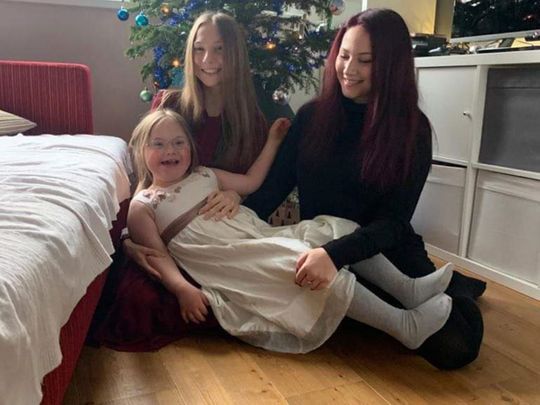
Nine-year-old Austrian, Antonia, lives in the moment. “I think she and many people with Down syndrome, they are very good at this – not thinking about yesterday or tomorrow, just living in the now,” says her mum, Karina Jellinek-Schneidewind. It’s a lesson that the former UAE resident is trying to imbibe, she says with a laugh during an interview with Gulf News.
When Antonia was still in the womb, a screening had discovered a congenital heart condition, Atrioventricular (AV) canal defect, which is a large hole in the centre of the heart. “It's a very common type of heart defect in children with a chromosome problem, Trisomy 21 (Down syndrome),” explains US-based Heart.org.
“The doctor said that with this heart condition the odds of her having Down syndrome is higher. So we did some more tests and we had the results [confirming the diagnosis] two weeks later,” adds the Gulf News reader.
What is Down syndrome?
“Down syndrome occurs due to the errors in the genetic code i.e. the child gets an extra chromosome making it 47 chromosomes instead of 46,” says UAE-based Dr Arif Khan, Paediatric Neurologist and Founder of Neuropedia.
He adds that this is the most common genetic cause of intellectual disability occurring at a rate of 1 in 700 live births.
This extra chromosome affects physical and mental development. Babies born with Down syndrome, explains Khan, tend to have:
- Flat face
- Slanting eyes
- Thick or short neck
- Low set ears
- Low muscle tone
- Short legs and hands
- Single palmar crease
- Shorter height than other’s their age
- Heart defects
The syndrome also tends to delay developmental milestones. “These children are very late in reaching their growth milestones. The development of motor, cognitive, speech or emotional skills are also delayed. However, not all areas of development are affected equally and there are different patterns of learning difficulties.
“There is a specific pattern of cognitive and behavioural features that are observed among children with Down syndrome that differs from that seen in typically developing children and children with other causes of intellectual disability. We refer to this pattern of characteristic strengths and weaknesses as a 'developmental profile',” says Dr Khan.
Some common traits include:
1. Social skills: These are not as delayed as other abilities such as number crunching.
2. Speaking: They have difficulties in expressive language, grammar and speech clarity. Their verbal memory is usually lagging and this makes it difficult for them to learn new words or sentences. However, they are generally good readers.
3. Visual intelligence: People with Down syndrome tend to learn visually – using pictures, gestures and objects during therapy is therefore helpful.
4. Behavioural issues: While these kids are friendly and social, says Dr Khan, they can sometimes come across as stubborn, rigid and impulsive.
5. Higher risk of health issues: They are at a much higher risk of developing a heart problems which are mostly congenital, Alzheimer's, sleep apnoea, autism, hearing loss, obesity and thyroid issues, he adds.

People with Down syndrome are at a much higher risk of developing a heart problems which are mostly congenital, Alzheimer's, sleep apnoea, autism, hearing loss, obesity and thyroid issues
Long stay in hospital
In Antonia’s case, the heart condition that accompanied Down syndrome meant a one and a half month stay in the hospital’s neonatal intensive care unit (NICU) before she was allowed to go home. In the early days – she was born three weeks early and needed oxygen – her mother recalls her tiny face and body covered in plastic channels, hooked on to screen that monitored her every breath, her every move.
“I had her for seconds then they had to give her air and then she was in NICU. The first time I saw her face was a few days later when they removed the mask. It is completely different if you give birth to a heathy child … but it was [her] heart that was giving her trouble. I couldn’t hold her,” she recalls. “I went to the hospital a few days on and I could take her out but in a hospital chair, with doctors and nurses and others around,” she says.
It meant an adjustment to the whole family – Antonia has two older siblings, then 10 and 8 years old, who had to make allowances for the new arrival. Fortunately, the kids took it in their stride. “It was not that big a deal for them, because they went to school where they had special needs kids; they were used to [some kids needing a little more help]. So we just told them what Down Syndrome means and what it means for the whole family,” she says.
There were some growing-used-to-the situation pains, but the family soon got acclimatised, says Karina.
The Jellinek-Schneidewind family, who currently live in Austria, moved to the UAE when Antonia turned one. They would stay on for five years. "It was easy to find a school for Antonia there …,” she says.
Your age when you get pregnant. Your risk of having a baby with Down syndrome increases as you get older, especially if you are age 35 or older.
Being a carrier of a certain type of Down syndrome. If you or your partner are a carrier of one type of Down syndrome (translocation Down syndrome), you carry (have) a gene change for the condition, but you don’t actually have the condition. You can pass the gene change to your baby, but it’s rare.
Already having a baby with Down syndrome. If you already have a baby with Down syndrome, your risk for having another is higher.
In addition to these factors, a father’s age may play a part too. a study, published in the American journal ‘The Journal of Urology’, states that “older fathers were responsible for up to 50 per cent of the rise in Down syndrome risk when the mother was also over 40.”
"Paternal age has an effect on Down syndrome but only in mothers 35 years old and older," researcher Harry Fisch, MD, of the department of urology at Columbia-Presbyterian Medical Center in New York City is quoted as writing by US-based WebMD. "In younger women, in whom age was not a risk factor for Down syndrome, there was no paternal effect."
The challenges the family faced, says Karina, have not really centred so much on Antonia’s condition. When raising children, she explains, there are bound to be some issues. “I think my challenges are not much different to other mothers’, because I focus on what the child needs –whether she has Down syndrome or not,” she explains. Every kid has his or her own special needs, wants and challenges, she explains.
But things get easier with patience and acceptance, she says.
And that’s the advice she wants to give other mums. “The most difficult and most important thing is to accept your child. I feel every child is different. If he or she has special needs, parents should try to accept the child, and love the child like he or she is. It makes life much easier. Especially with a child with Down syndrome, if they feel the love, then it’s so easy [to help them grow],” she says.
Tell us about your parenting journey by writing in to us at parenting@gulfnews.com








